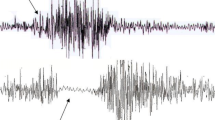Summary
In 24 Wistar-rats the right Stenon duct was tied off and the gland tissue studied by light- and electron microscopy at different time intervals after duct ligation (6 hours to a maximum of 6 months). The left parotid gland was used for comparsion. The earliest and most pronounced structural changes were found at the highly differentiated acini of the gland (fragmentation and vesicular transformation of the endoplasmatic reticulum, focal cytoplasm necroses, osmiophilic inclusions, mucoid transformations of the secretory granula).
The dissolution process going hand in hand with the necroses of the acini cells comes to an end on day 10 of the experiment. Damages to the duct system appears later. Corresponding to the degree of differentiation the destruction of the interlobular ducts is more severe and appears earlier than that of the intercalated ducts. After 4–6 months the structural change in the duct system leads to the formation of indifferent ducts, as in an embryonic parotid gland. The myoepithelial cells remain intact and prove to be a separate cell system. The reactions of the connective tissue in the salivary gland together with the parenchymal atrophy result in abacterial sclerosis of the salivary-gland tissue. The transformation of the parotid gland after experimental duct ligation corresponds to diseases of the human salivary gland (chronic sialadenitis, sialolithiasis, radiation injury) in its course and in the location and extent of pathologic structural changes. The tissue reaction of the salivary glands to noxious influences of different etiology is obviously limited. Only the immunologically induced alterations of the gland show specifical patterns of histological reactions.
Zusammenfassung
Bei 24 weiblichen Wistar-Ratten wurde der rechte Parotisausführungsgang unterbunden und das Drüsengewebe in verschiedenen zeitlichen Abständen nach der Gangligatur (6 Std bis maximal 6 Monate) licht- und elektronenmikroskopisch untersucht. Die linke Parotis wurde als Vergleichsobjekt verwendet. Die frühesten und stärksten Veränderungen finden sich an den hochdifferenzierten Drüsenacini (Fragmentation und vesiculäre Transformation des endoplasmatischen Reticulums, fokale Cytoplasmanekrosen, osmiophile Einschlüsse, mucoide Transformation der Sekretgranula). Der mit Acinuszellnekrosen einhergehende Auflösungsprozeß ist mit dem 10. Versuchstag weitgehend abgeschlossen. Die Schädigungen des Gangsystems treten zeitlich später auf. Entsprechend dem Differenzierungsgrad sind die Destruktionen der Streifenstücke stärker und auch zeitlich früher als die der Schaltstücke. Die Strukturumwandlung des Gangsystems führt nach 4–6 Versuchsmonaten zu indifferenten Gangformationen vom Typus einer embryonalen Speicheldrüse. Die Myoepithelzellen bleiben intakt und erweisen sich als eigenständiges Zellsystem. Die am Speicheldrüsenmesenchym ablaufenden Reaktionen führen zusammen mit der Parenchymatrophie zu einer abakteriellen Speicheldrüsensklerose. Die Umgestaltung der Parotis nach experimenteller Gangunterbindung entspricht sowohl im zeitlichen Ablauf als auch der Lokalisation und dem Stärkegrad Befunden, wie sie bei Spontanerkrankungen menschlicher Speicheldrüsen (chronische Sialadenitis, Speichelsteinen, Strahlenschäden) zu beobachten sind. Die Gewebsreaktion des Speicheldrüsengewebes gegenüber Noxen unterschiedlicher Ätiologie ist offensichtlich begrenzt. Lediglich immunologisch ausgelöste Prozesse zeigen spezielle Reaktionsmuster.
Similar content being viewed by others
Literatur
Donath, K., Feustel, P., Seifert, G.: Ultrastrukturelle Veränderungen der Speicheldrüsenacini nach experimenteller Äthionineinwirkung. Virchows Arch. Abt. A. 353, 360–374 (1971).
Donath, K., Seifert, G.: Ultrastruktur und Pathogenese der myoepithelialen Sialadenitis. Virchows Arch. Abt. A 356, 315–329 (1972).
Donath, K., Seifert, G., Schmitz, R.: Zur Diagnose und Ultrastruktur des tubulären Speichelgangcarcinoms. Epithelial-myoepitheliales Schaltstückcarcinom. Virchows Arch. Abt. A 356, 16–31 (1972).
Hamperl, H.: The myothelia (myoepithelial cells). Normal state; regressive changes; hyperplasia; tumors. Curr. Top. Pathology 53, 161–220 (1970).
Hirsch-Hoffmann, H.-U.: Ultrastrukturelle Untersuchungen der Rattenparotis nach Gangunterbindung. Diss. Hamburg 1972.
Hübner, G., Kleinsasser, O., Klein, H. J.: Zur Feinstruktur der Speichelgangcarcinome. Ein Beitrag zur Rolle der Myoepithelzellen in Speicheldrüsengeschwülsten. Virchows Arch. Abt. A 346, 1–14 (1969).
Langbein, H., Rauch, S., Seifert, G.: Histochemische und autoradiographische Speicheldrüsenveränderungen nach partieller Speicheldrüsenresektion. Z. Laryng. Rhinol. 50, 672–685 (1971).
Pirsig, W., Donath, K.: Zur Ultrastruktur der Parotis beim Sjögren-Syndrom vor und nach immunsuppressiver Therapie. Arch. klin. exp. Ohr.-, Nas.- u. Kehlk.-Heilk. 201, 309–323 (1972).
Rauch, S.: Die Speicheldrüsen des Menschen. Stuttgart: Thieme 1959.
Rauch, S., Seifert, G., Gorlin, R. J.: Diseases of the salivary glands. In: Oral pathology, 6. ed. by R. J. Gorlin and H. M. Goldman, vol. 2, p. 962–1070. St. Louis: Mosby Co. 1970.
Schneyer, L. H., Schneyer, Ch. A.: Secretory mechanisms of salivary glands. New York-London: Academic Press 1967.
Seifert, G.: Mundhöhle, Speicheldrüsen, Tonsillen, Rachen. In: Spezielle pathologische Anatomie, hrsg. von W. Doerr, G. Seifert und E. Uehlinger, Bd. 1, S. 1–415. Berlin-Heidelberg-New York: Springer 1966.
Seifert, G.: Klinische Pathologie der Sialadenitis und Sialadenose. H.N.O. 19, 1–9 (1971).
Seifert, G., Geier, W.: Zur Pathologie der Strahlen-Sialadenitis. Z. Laryng. Rhinol. 50, 376–388 (1971).
Tamarin, A.: Secretory cell alterations associated with submaxillary gland duct ligation. In: Secretory mechanisms of salivary glands, ed. by L. H. Schneyer and Ch. A. Schneyer, p. 220–237. New York-London: Academic Press 1967.
Tamarin, A.: Submaxillary gland recovery from obstruction. I. Overall changes and electron microscopic alterations of granular duct cells. J. Ultrastruct. Res. 34, 276–287 (1971).
Tamarin, A.: Submaxillary gland recovery from obstruction. II. Electron microscopic alterations of acinar cells. J. Ultrastruct. Res. 34, 288–302 (1971).
Author information
Authors and Affiliations
Additional information
Herrn Prof. Dr. W. Giese, Münster (Westf.), zum 70. Geburtstag gewidmet.
Mit Unterstützung durch die Deutsche Forschungsgemeinschaft.
Rights and permissions
About this article
Cite this article
Donath, K., Hirsch-Hoffmann, H.U. & Seifert, G. Zur Pathogenese der Parotisatrophie nach experimenteller Gangunterbindung. Virchows Arch. Abt. A Path. Anat. 359, 31–48 (1973). https://doi.org/10.1007/BF00549081
Received:
Issue Date:
DOI: https://doi.org/10.1007/BF00549081




